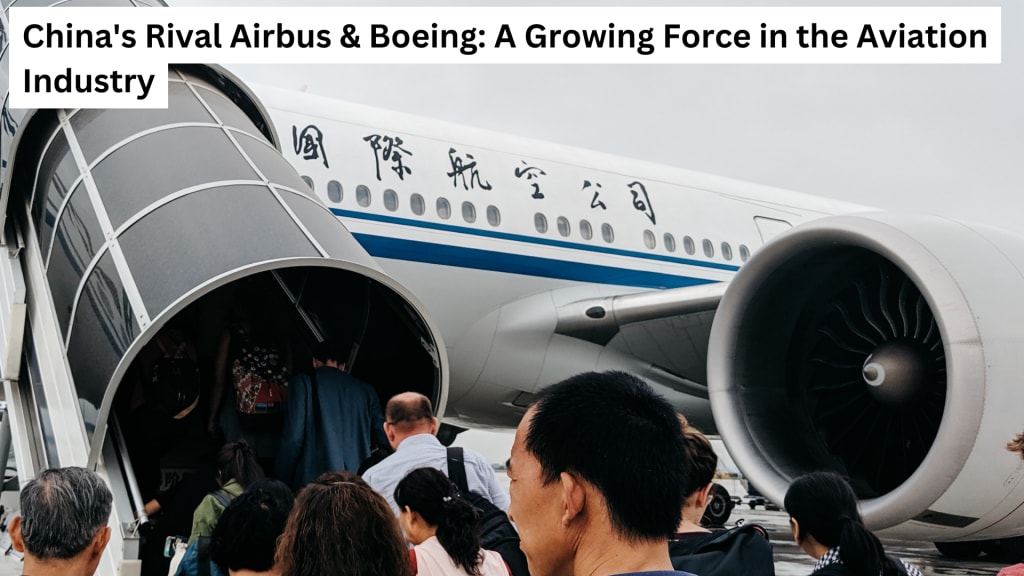China's Rival Airbus & Boeing: A Growing Force in the Aviation Industry
China's Aerospace Ambitions: Challenging the Airbus-Boeing Duopoly

Introduction:
The aviation industry has long been dominated by two major players, Airbus and Boeing. These giants have set the standards for commercial aircraft manufacturing and have enjoyed a duopoly in the market for decades. However, a new player has emerged on the scene, challenging the dominance of Airbus and Boeing - China.
China's aerospace industry has made remarkable strides in recent years, with ambitions to become a major competitor in the global aviation market. By investing heavily in research, development, and manufacturing capabilities, China aims to establish its own aircraft manufacturing companies and break the duopoly held by Airbus and Boeing. This article explores China's growing influence and its quest to become a prominent force in the aviation industry.
Government Support and Ambitious Plans:
China's aviation aspirations are backed by robust government support. The Chinese government recognizes the strategic importance of a strong domestic aerospace industry, both for economic growth and national security. It has provided substantial financial resources and policy support to propel the development of indigenous aircraft manufacturing companies.
One of the notable endeavors is the Commercial Aircraft Corporation of China (COMAC). Established in 2008, COMAC aims to compete directly with Airbus and Boeing by producing commercial aircraft for both domestic and international markets. Its flagship project is the C919, a narrow-body aircraft designed to challenge the Airbus A320 and Boeing 737. The C919 has garnered significant attention, with orders from both domestic and international airlines.
Technological Advancements and Collaboration:
China's aviation industry has made considerable strides in technological advancements. To bridge the gap with Airbus and Boeing, Chinese manufacturers have sought collaboration with established aerospace companies worldwide. For instance, COMAC has partnered with international suppliers, including GE and Safran, to incorporate advanced engines and systems into its aircraft.
Furthermore, Chinese manufacturers are investing in research and development to enhance their technological capabilities. The focus is on developing cutting-edge technologies, such as composite materials, advanced avionics, and fuel-efficient engines. These efforts aim to improve performance, reduce fuel consumption, and meet international safety and regulatory standards.
Market Potential and Global Impact:
China's rise as a global economic powerhouse has fueled the growth of its aviation market. With a burgeoning middle class and increasing air travel demand, China represents a significant market opportunity for aircraft manufacturers. Recognizing this potential, both Airbus and Boeing have established partnerships and production facilities in China.
Airbus, in particular, has forged strong ties with China. It has established an assembly line for the A320 family in Tianjin, catering to the domestic market. Additionally, Airbus has inked agreements with Chinese airlines for the purchase of its aircraft, solidifying its presence in the country.
Boeing has also embraced China as a key market. The company has set up a completion and delivery center in Zhoushan, facilitating the final assembly and delivery of Boeing 737 aircraft to Chinese customers. Boeing has actively engaged in partnerships and collaborations with Chinese aerospace companies to tap into the market potential.
Challenges and Competition:
While China's aviation industry has made remarkable progress, it faces several challenges on its path to becoming a global aviation powerhouse. One of the primary obstacles is building a reputation for safety and reliability. Airbus and Boeing have decades of experience and a track record of producing safe and efficient aircraft, while Chinese manufacturers are still working to establish their credentials in this regard.
Moreover, China's aerospace industry faces stiff competition from established players. Airbus and Boeing have well-established supply chains, vast customer networks, and strong brand recognition. Chinese manufacturers must navigate these competitive landscapes while continuously improving their capabilities to gain market share.
Conclusion:
China's rapid development in the aviation industry has positioned it as a growing force, challenging the duopoly held by Airbus and Boeing. With substantial government support, technological advancements, and collaborations with international partners, China aims to establish its presence in the global aviation market. The potential of China's domestic market and its ambition to export aircraft will undoubtedly reshape the dynamics of the industry.
As China's aerospace industry continues to mature, it will be intriguing to observe how it navigates the challenges and competes with established players. The growth of China's aviation sector not only signifies its economic might but also offers opportunities for innovation, collaboration, and healthy competition in the global aviation industry.
About the Creator
Plantera Digital Media
welcome to my page here i share
- Stories
- Interesting facts about the world around us
- Thought-provoking theories about the nature of reality
- Useful information that can help people in their lives






Comments
There are no comments for this story
Be the first to respond and start the conversation.